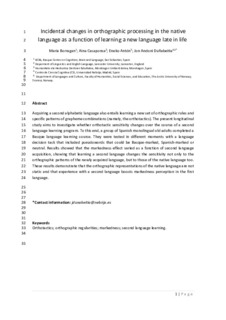| dc.contributor.author | Antón, Eneko | |
| dc.contributor.other | Borragan, Maria | |
| dc.contributor.other | Casaponsa, Aina | |
| dc.contributor.other | Duñabeitia, Jon Andoni | |
| dc.date.accessioned | 2020-07-24T11:18:20Z | |
| dc.date.available | 2020-07-24T11:18:20Z | |
| dc.date.issued | 2020 | |
| dc.identifier.issn | 2327-3798 | en |
| dc.identifier.issn | 2327-3801 | en |
| dc.identifier.other | https://katalogoa.mondragon.edu/janium-bin/janium_login_opac.pl?find&ficha_no=159356 | en |
| dc.identifier.uri | https://hdl.handle.net/20.500.11984/1804 | |
| dc.description.abstract | Acquiring a second alphabetic language also entails learning a new set of orthographic rules and specific patterns of grapheme combinations (namely, the orthotactics). The present longitudinal study aims to investigate whether orthotactic sensitivity changes over the course of a second language learning programme. To this end, a group of Spanish monolingual old adults completed a Basque language learning course. They were tested in different moments with a language decision task that included pseudowords that could be Basque-marked, Spanish-marked or neutral. Results showed that the markedness effect varied as a function of second language acquisition, showing that learning a second language changes the sensitivity not only to the orthographic patterns of the newly acquired language, but to those of the native language too. These results demonstrate that the orthographic representations of the native language are not static and that experience with a second language boosts markedness perception in the first language. | en |
| dc.description.sponsorship | This work was supported by Comunidad de Madrid: [grant number H2019/HUM-5705]; La Caixa Foundation: [grant number LCF/BQ/ES16/11570003]; Gobierno de España: [grant number PGC2018-097145-B-I00,RED2018-102615-T]. This study was partially supported by grants RED2018-102615-T and PGC2018-097145-B-I00 from the Spanish Government, H2019/HUM-5705 from the Comunidad de Madrid, and by a fellowship from La Caixa foundation (ID 100010434, code LCF/BQ/ES16/11570003) | en |
| dc.language.iso | eng | en |
| dc.publisher | Taylor & Francis Group | en |
| dc.rights | © 2020 Informa UK Limited | en |
| dc.subject | Orthotactics | en |
| dc.subject | Orthographic regularities | en |
| dc.subject | Markedness | en |
| dc.subject | Second language learning | en |
| dc.title | Incidental changes in orthographic processing in the native language as a function of learning a new language late in life | en |
| dcterms.accessRights | http://purl.org/coar/access_right/c_abf2 | en |
| dcterms.source | Language, Cognition and Neuroscience | en |
| local.contributor.group | Berrikuntza eta esku-hartzea gizarte kulturanitz eta eleanitzetan | eu |
| local.description.peerreviewed | false | en |
| local.identifier.doi | https://doi.org/10.1080/23273798.2020.1784446 | en |
| local.contributor.otherinstitution | https://ror.org/01a28zg77 | en |
| local.contributor.otherinstitution | https://ror.org/04f2nsd36 | en |
| local.contributor.otherinstitution | https://ror.org/03tzyrt94 | es |
| local.contributor.otherinstitution | https://ror.org/00wge5k78 | en |
| oaire.format.mimetype | application/pdf | |
| oaire.file | $DSPACE\assetstore | |
| oaire.resourceType | http://purl.org/coar/resource_type/c_6501 | en |
| oaire.version | http://purl.org/coar/version/c_71e4c1898caa6e32 | en |







